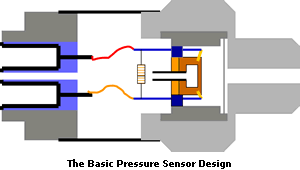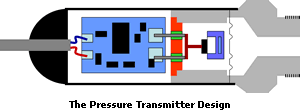Typically, a pressure sensor is used to measure the pressure of fluids (gases or liquids). Pressure is an expression of the force required to stop a fluid from expanding, and is usually stated in terms of force per unit area. A pressure sensor generates an electrical signal relating to the pressure imposed. Such a signal is normally digital or analogue, although optical, visual and auditory signals are also common.
Industrial pressure sensors, also referred to as pressure transducers, pressure transmitters, pressure indicators and pressure switches, normally have a diaphragm type design that uses strain gauges, which are either bonded to, or diffused into it, with the strain gauges acting as resistive elements. Under the pressure-induced strain, the resistive values change. In capacitive technology, the pressure diaphragm is a single plate of a capacitor that changes its value under pressure-induced displacement.

Pressure sensing using diaphragm technology measures the difference in pressure of the two sides of the diaphragm. Depending on the relevant pressure, the terms ‘Absolute’ is used when the reference is vacuum; ‘Gauge’ (also known as ‘gage’) is used where the reference is atmospheric pressure; and ‘Differential’ is used where the sensor has two ports for the measurement of two different pressures.
Pressure sensors are used in a wide variety of applications for control and monitoring purposes. Pressure sensors can also be used to indirectly measure other variables such as fluid flow, speed, water level and altitude.
Pressure sensors vary considerably in their design, technology used, performance, application and cost. World-wide, there are hundreds of different technologies used in pressure sensor designs and thousands of different suppliers of pressure sensors.

Certain types of pressure sensor are designed to measure dynamically and are able to capture very high speed changes in pressure. Example applications here are in the measurement of combustion pressures in engine cylinders or gas turbines. These sensors are normally manufactured using piezoelectric materials such as quartz.
Some pressure sensors operate using a binary method. In this design, when pressure is applied to a pressure sensor, the sensor completes or breaks an electrical circuit. These types of sensors are also referred to as pressure switches.
Pressure sensors can be classified in terms of the pressure range they are measuring, operating temperature range, or the type of pressure they are measuring. In terms of pressure types, pressure sensors can be divided into several main categories:
Absolute Pressure Sensors
An absolute pressure sensor measures the pressure relative to perfect vacuum pressure (0 PSI or no pressure). Atmospheric pressure is 101.325 kPa (14.7 PSI) at sea level with reference to vacuum.
Gauge Pressure Sensors
A gauge pressure sensor is used in different applications because it can be calibrated to measure the pressure relative to a given atmospheric pressure at a given location. A tyre pressure gauge is an example of gauge pressure indication.
Vacuum Pressure Sensors
A vacuum pressure sensor is used to measure pressure less than the atmospheric pressure at a given location.
Differential Pressure Sensors
A differential pressure sensor or transmitter measures the difference between two or more pressures introduced as inputs to the sensing unit. For example, measuring the pressure drop across an oil filter. Differential pressure is also used to measure flow or level in pressurised vessels.
Sealed Pressure Sensors
A sealed pressure sensor is similar to the gauge pressure sensor, except that it has already been calibrated by the manufacturer to measure pressure relative to sea level pressure.